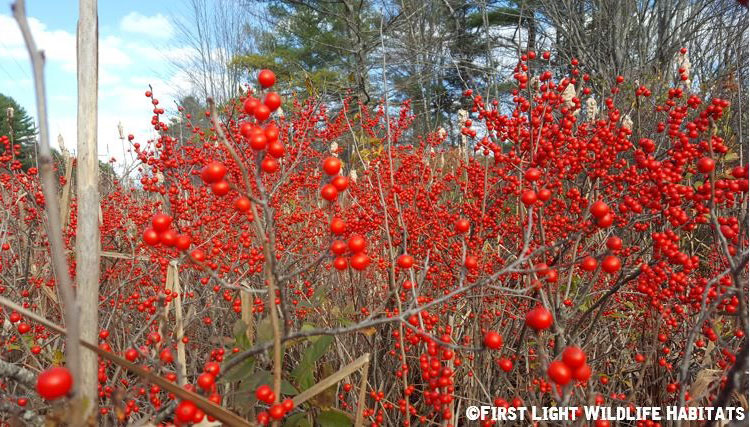It’s “the most wonderful time of the year” to spot winterberry on roadsides and in wet meadows and swamps.
The scarlet-red berries of our native holly are literally exploding with color right now. Once the snow falls, the display will be even more magical.
Commonly known as winterberry, Ilex verticllata is one of my all-time favorite shrubs. Its scarlet berries seem to literally glow against the gray and brown muted landscapes of our roadsides and wetlands in the late fall and early winter.

As I wait for that first blanketing of snow I feel like winterberry is the decorative red ribbon on a beautifully wrapped package, just waiting to be opened. When snow transforms the dreary colors into a winter wonderland, the bright red berries will announce their place in the world—nature’s Christmas ornaments!
All told, I am not being dramatic when I say that the sight of winterberry actually makes my heart sing.
I’m not alone. Winterberry is highly prized for outdoor Christmas decor. Right now it’s everywhere. Bunches of it can be found for sale in small roadside stands and at local nurseries and farm stores— and for good reason. The cheerful berries on their plain gray stems are the perfect accent to evergreen boughs in a porch or deck planter.
Some birds prize these berries, but for altogether different reasons. They do not desire a splash of color to lift their spirits at the darkest time of the year (although, surely the sight of the berries does boost their spirits). No, for our wild birds toughing out the winter, their draw to winterberry is rooted in their instinct to survive.
The berries of this shrub are like winter jewels for waxwings, cardinals, over-wintering bluebirds and robins, and other birds seeking much-needed nourishment throughout winter.
Winterberry is unique in that the fruits do not drop to the ground after they become ripe; they hang on to the stem and persist for weeks to months. Even under freeze and thaw cycles, they hang on.
For this reason, they are called “persistent” fruits. Other shrubs with winter-persistent fruits include viburnum, crabapples, chokecherry, hawthorns, and sumac.
All of these are visited and eaten by birds in winter and are great choices to plant in any habitat garden or managed landscape because they significantly improve the habitat quality.
If you planted a winterberry shrub in your yard, farm, or business campus, just think how much joy you would get out of seeing the abundant red berries this time of year.
Opt for planting a shrub to bring the Christmas colors home. You won’t have to trudge into the swamp or pay for cut stems again. You would get to enjoy the colorful berries on live stems year after year, and in growing number as the shrub matures.
What’s really great, is that birds tend to eat these berries later in the year, during the deep cold of mid-winter. So, first you get a showy flush of berries around the holidays, and then you get to enjoy all the birds that will be attracted to its berries later in the winter season.
Talk about a double-duty plant!
When the shrub has leaves (spring into fall) it provides great nesting and feeding cover for birds, as well.
Wonderful winterberry, indeed! The gift that keeps on giving.
In 2018, consider planting a winterberry shrub or two to liven up the landscape and attract some beautiful birds to your property!
GO ON….put it on the list, I know you are already scheming for next year’s growing season. Am I right?
To book your customized consultation, habitat design, talk, walk, or workshop, or to sign up for the newsletter, visit www.firstlighthabitats.com.
Sometimes protecting the earth can seem overwhelming. But there are things people can do in their own yard to make the world a better place for native wildlife. Several times each month, Deborah Perkins will be sharing her 25 years of knowledge and experience with readers of this blog. The tips she provides here are just a small sampling of what she provides to clients interested in creating habitat for birds, bees, butterflies, and other wildlife. Visit her First Light Wildlife Habitats for more information about how Deb can help you enhance your property for the benefit of native wildlife.











Interested in planting some but I don’t think our land is wet enough
Now that I have taken the pines and oak trees out that were smothering the winterberry, I can’t wait to see what it looks like in the fall! Thanks Deb! Might just have to plant a few more of these!
That’s wonderful, Sally! I am just seeing your comment now. I hope your habitat projects have gone beautifully and your winterberry is thriving now!
That’s wonderful, Sally! I am just seeing your comment now. I hope your habitat projects have gone beautifully and your winterberry is thriving now!